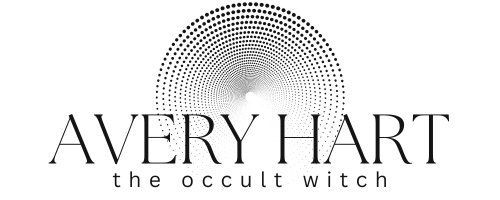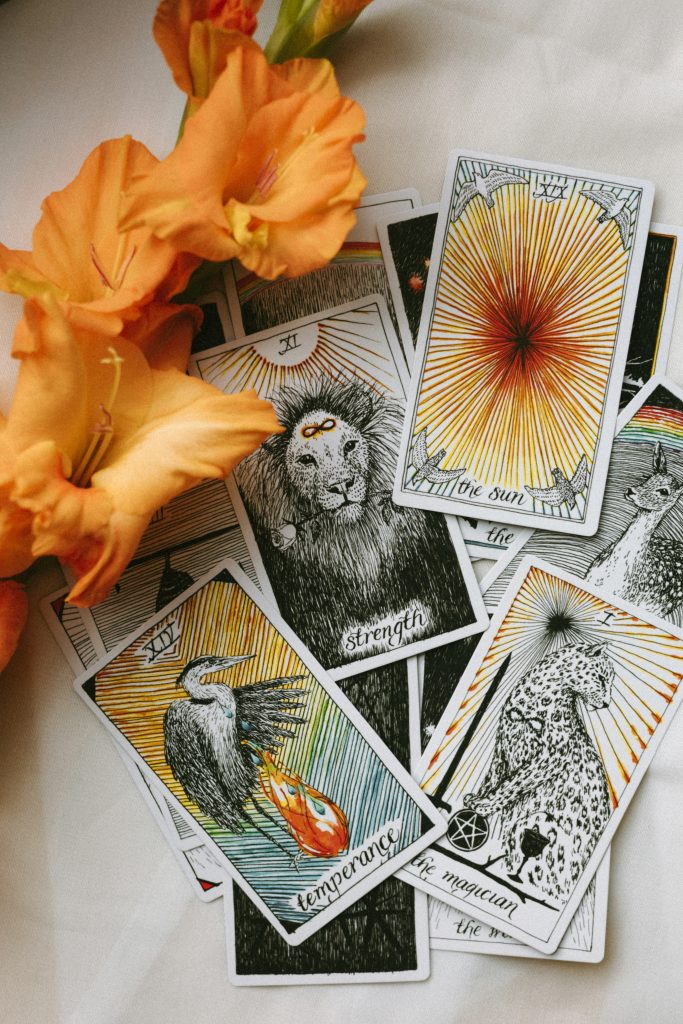Hello, my name is Dr. Alexander Cummins. I’m a professional diviner and consultant sorcerer as well as an academically trained historian of magic. My preferred method of divination I use professionally and personally is European Renaissance geomancy. In fact, I love it so much I’ve been teaching geomantic divination for some years now.
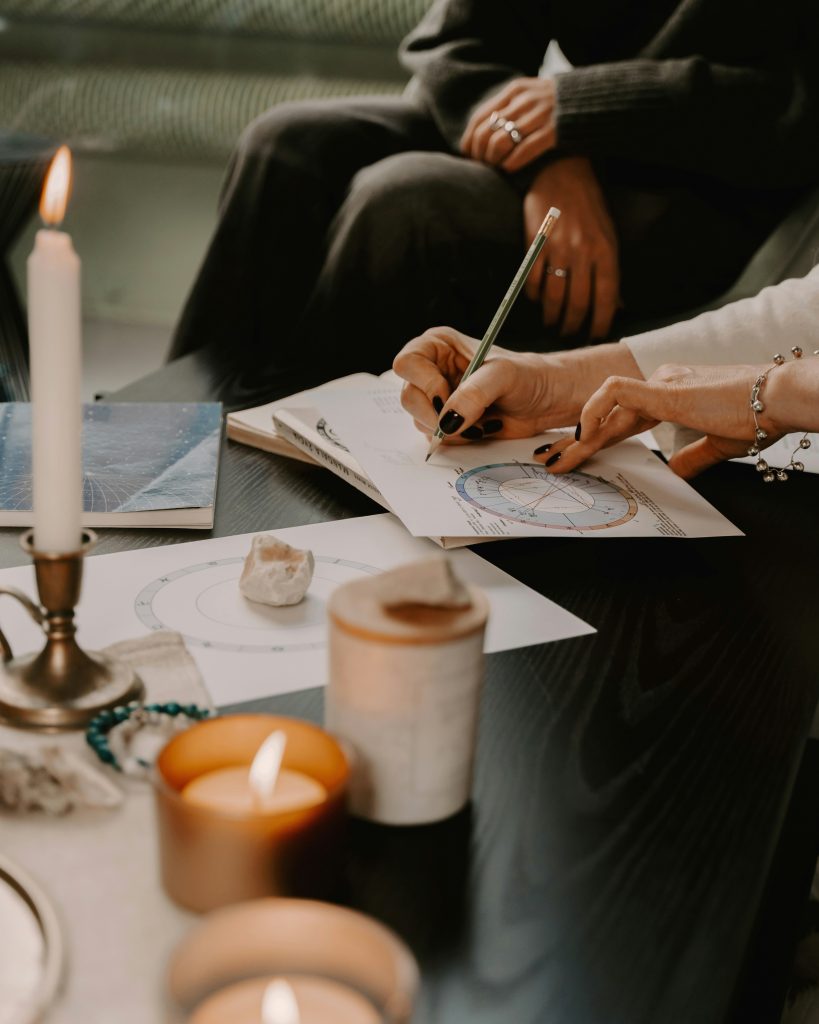
I still love describing the sixteen figure-answers of this form of divination as if they were pubs and taking students on a pubcrawl-pathworking through them, familiarizing them with some of the events, situations, feelings, and spirits that haunt those establishments. Moreover, I love introducing people to a system of divination they either didn’t know anything about or had preconceptions around, that proves its elegance and ease-of-use to them through study and application.
As such, I thought it might make sense to answer a few very basic questions about what geomantic practices are and aren’t, and how I do it, for folks unsure of what I’m even banging on about.
So What Is Geomancy?
It’s a system of sortilege essentially. In a geomantic reading, you can throw dice, flip coins, toss sticks or any other method you choose to determine odd or even results. The answers, called figures, are made up of four lines of single or double dots. To make one of these figures of geomancy you generate a set of four odd or even results. Arrange them top to bottom. That’s basically it. Everything else proceeds from there.
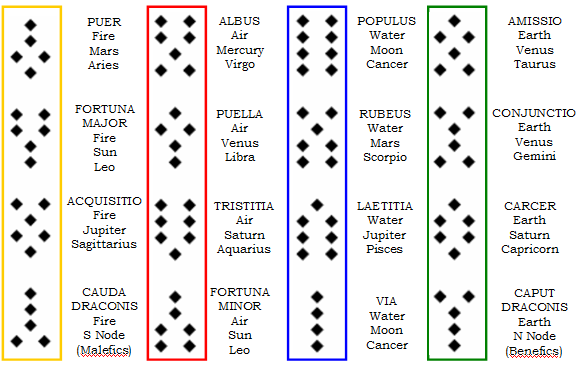
Why is it called geomancy though?
My favorite explanation is that the ‘geo-‘ doesn’t just refer to Earth and mean it only looks at one-quarter of the four classical elements and ignores Fire, Air, and Water. As you can see from the figures above, geomancy definitely has room for all the four elements! Rather, it is said the ‘geo’ means worldly – geomancy deals with the natural world we are in and what to do practically about the situations at hand.
Is it like dowsing or ley-line stuff?
No. There are a good many traditions and practices that also call themselves geomancy that do these sorts of Earth Mysteries practices, but European Renaissance geomancy is primarily a particular system of divination with rules and books and so on. You pose a particular question to the oracle and generate a particular answer by setting a chart that can be analyzed and interpreted. Very different.
I heard it was called the “sister of astrology”, what does that mean?
Geomancy uses the rules and forms of astrological meanings without bothering with any actual astronomical alignment, sky-maths or star-measuring. The sixteen figures I spoke of above that make up the system are each ruled by one of the seven classical planets. Venus rules the figure we call Puella (The Lady) for instance. So we could say geomancers speak in the grammar of the stars. But because we generate our figures by sortilege (dice, coins, sticks, etc) we don’t need to resort to any telescopes or ephemerides or smart-phone apps to know where the actual stars are.
So do I need to know lots of astrology to geomance?
If you know your Four Elements and your Seven Planets, you’re most of the way there. And then if you know the Twelve Houses – how astrology divides up a complex situation – you’re basically set! But we certainly go over all this, including the Houses and their particular uses in geomancy, in the Foundation training I offer.
What Does A Full Geomancy Reading Look Like?
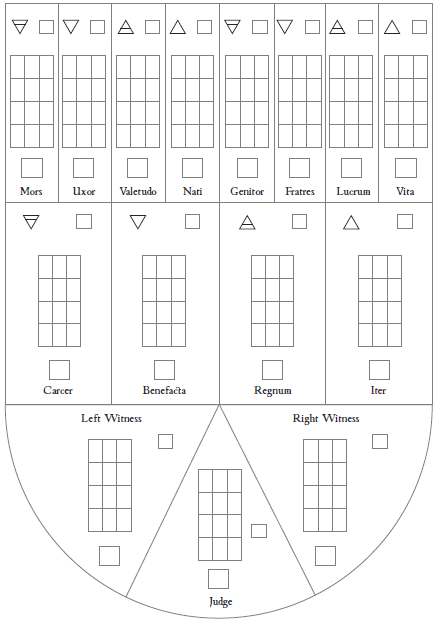
A full geomantic chart is called a shield – because, yeah, it’s kind of shield-shaped, see – and can be thought of like a 15-place Tarot card spread. The first twelve places of such a shield chart are assigned to the traditional Twelve Houses of astrology, which is another instance of using the grammar or “symbol sets” of astrology without any actual astronomy. So if you wanted to know about, say, your love-life – which would typically be a Seventh House matter – you’d cast a shield chart and pay special attention to the figure that landed in the seventh place, Uxor, on the shield. [ED: There are other ways of doing this, other variant geomantic techniques – we geomancers sure do love our variant techniques! – but this is the simplest form I find works very well.]
The last three places of a shield after the Twelve Houses are called the Court of the shield. We call these places the two Witnesses and the Judge. The Court can be considered the distillation of the whole reading into a straightforward judgment on the question put to the oracle, with supporting understanding of how or why that answer is what it is.
My readings last about an hour overall, and always pull out things to actually do about the situation we analyze: how to avoid the things that the shield warns us about, and how to secure the blessings and benefits it might identify. This ranges from foods to avoid – derived from my study of humoural theory and its relation to the elemental basis of sixteen possible figures and elemental places and zones in the chart – as well as cleansings, talismans, and spell-work that can be performed to help.
Isn’t it all really maths-based?
Not especially no! This is the most common thing I hear from folks and it surprises me. I hated maths in school and I love geomancy! A shield is started by making figures and then further generated by adding figures to other figures in a pretty straight-forward and completely internally consistent manner. Again, it’s all about odds or evens. The four lines of one figure get added to the four lines of another each other to produce new odds and evens that produce new figures. Let’s take an example.

In other words, if you can count to four, you’re all good to go!
But what does this adding figures together to make new figures actually mean? In terms of reading and interpretation of, you know, divination. Well, let’s look at the above example with added geomantic meanings.
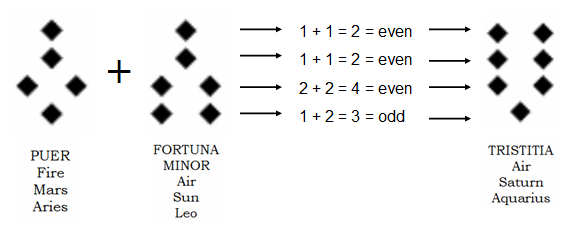
The patterns of energies and virtues expressed in the Martial figure of Puer (The Boy, or the Young Warrior) are about enthusiasm, vim, pep, chutzpah and other great-sounding words like that. When that pattern meets the pattern described by the second figure of Fortuna Minor (the Lesser Fortune), which described the easy-come-easy-go fickleness of luck and fate, the result is always the Saturnine figure of Tristitia (Sorrow), a figure of disappointment and brooding. So should this sequence of patterns fall in a reading about the future we are recommended to make sure our boundless enthusiasm isn’t dented by temporary setbacks or changes in plans and becomes soured to bitterness. Make sense?
Isn’t this a bit like the I Ching?
Structurally, quite a bit yes. European Renaissance geomancy comes from medieval Arabic divination systems originally, but the notion of answers made of lines that are broken or unbroken is pretty damn similar operationally to European geomancy’s single and double dots. The major difference being that geomancy’s four-line answers mean there are only sixteen figures, whereas the Book of Changes six-line figures produce sixty-four hexagrams!
What that means practically is a hexagram is often read more like a Tarot card – lots of meanings, wisdoms, exegeses, cautions, and assurances wrapped up around a single divined unit. Whereas geomantic figures are read in sequence and in relation to one another to put together practical guidance, as we saw earlier with our advice about being careful the shifts of the Lesser Fortune don’t dampen the Young Warrior’s spirits.
How Is Geomancy Different From Tarot Then?
If we can talk about the character and ‘feel’ of these two excellent oracles, I would say Tarot often feels to me like a chatty but slightly eccentric auntie – full of fascinating insights and tangents and symbols and archetypes. For me at least, it allows excellent and fruitful contemplation, meditation, and exploration of thoughts, feelings, and personal meanings.
Geomancy, on the other hand, is a bit more blunt, far more direct and a little more practical: it concerns itself with patterns of action and inertia that will produce further patterns, in interactions, in external influences and in grounded activity. It can assess with great accuracy yes-or-no questions, as well as be interrogated to produce incredibly useful advice for moving forward in your endeavors and projects in a successful manner. It also frames the interrelations of different facets of a circumstance or situation or event or plan in what I consider to be a singularly excellent and efficient way.
What do you use geomancy for?
I read for clients who come to me with any and every form of the usual questions about love, money, career, and changes in circumstances. I also help other artists, magicians, and artisans in planning, executing and completing projects: from rituals to art exhibitions and installations, to various neighborhood community programs. I also help people navigate interpersonal relationships, from reconciling estranged family or friends, to assisting in recovering from various traumas alongside other therapeutic regimes and medicaments.
I plot all my professional and personal spell-work with geomantic principles that chart how to most effectively perform my rites and enchantments, for the construction of talismans, and everything in between. I confirm contact and messages from the spirits with whom I work, whether in dream, inspiration, or trance. Being so firmly founded in elemental and planetary magic, geomancy is especially excellent for reading and improving in the various practices known as the “Western magical traditions”. I also use more down’n’dirty geomancy – throwing a couple of figures rather than setting a whole chart – if I’m out in the field and find, say, an interesting rock or a strange device on the subway or arresting little statue in a junkshop to check “hey, is this thing cursed?” Geomancy has a whole range of applications and techniques to suit different practices and practitioners.
I have a very specific question you haven’t addressed – could you tell me more?
I would be delighted to! My email address is consultantsorcerer@gmail.com and I would be happy to try to answer your question as best as I can.
I have a couple of bibliographic blog-posts: one detailing which modern geomantic texts I think are really great, and another offering full scans and some introductory assessments of early modern geomancy handbooks from the sixteenth- and seventeenth-centuries. I hope these are helpful for inquiring minds!
Struggling with your magic?
Take the Quiz to Discover Your #1 Witchcraft Obstacle
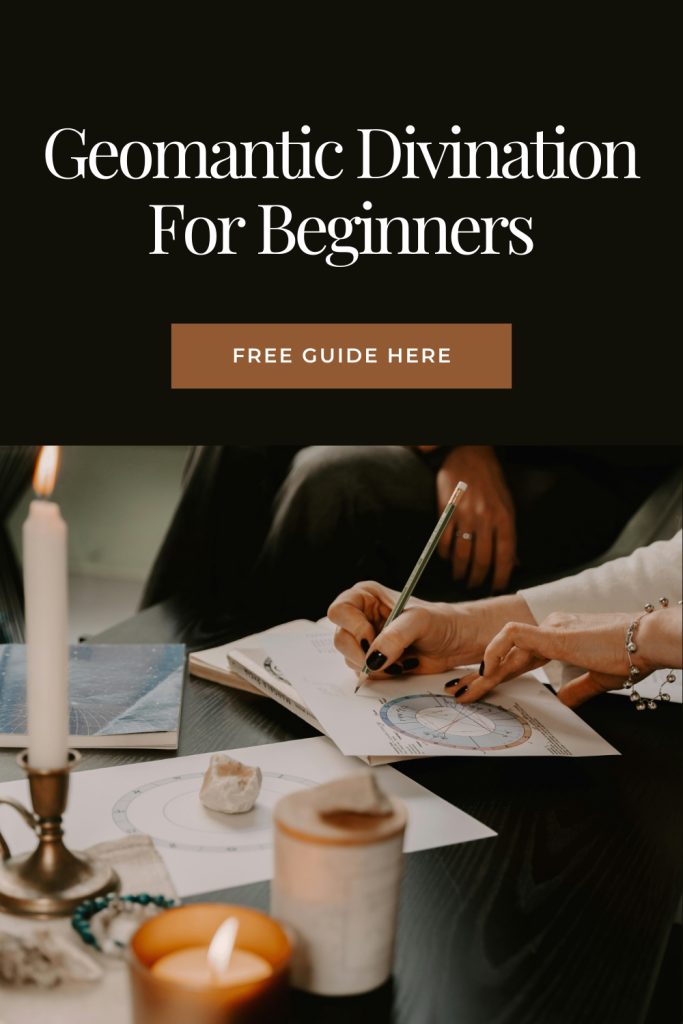
Updated on November 18, 2024 by Avery Hart
